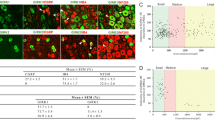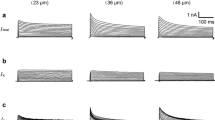Abstract
Backgrounds
Sodium channel Nav1.8 is expressed preferentially in members of the peripheral nervous system such as nociceptive dorsal root ganglion (DRG) neurons.
Methods
Using immunocytochemistry and eletrophysiological recording, we found that a subpopulation of small DRG neurons, grouped by isolectin B4 (IB4) immunoreactivity, showed a different use-dependent inactivation of Nav1.8 current, and this situation changed over time during in vitro culture.
Results
The IB -4 immunoreactivity of DRG neurons was not changed during in vitro culture with the exception of this small population of IB4-negative small-diameter DRG neurons. The Nav1.8 channel in IB +4 neurons underwent a level of use-dependent inactivation that was significantly stronger than that seen in IB -4 neurons at 1 and 2 days-in-vitro (DIV). The use-dependent inactivation of the Nav1.8 channel in IB +4 neurons at 1 DIV was significantly attenuated at 2 DIV. The values for voltage dependency of activation and steady-state inactivation of Nav1.8 were similar in all subpopulations of DRG neurons and did not change over time. The time constant for entry into slow inactivation of Nav1.8 in IB +4 neurons was significantly faster than in IB -4 neurons at 1 and 2 DIV, while the rate of recovery from slow inactivation of Nav1.8 in IB +4 neurons was slower than that seen in IB -4 neurons. Moreover, the time constant for entry into the slow inactivation of Nav1.8 in IB +4 neurons after 1 DIV was significantly faster than at 2 DIV, and the rate of recovery from the slow inactivation of Nav1.8 in IB +4 neurons at 1 DIV was slower than that at 2 DIV, which indicated that the strong use-dependent inactivation in IB +4 neurons at 1 DIV was the result of a greater preference for the slow inactivation state than at 2 DIV.
Conclusion
Our data suggest that the time-dependent change of the use-dependent inactivation of the Nav1.8 channel in DRG neurons cultured in vitro would contribute to the excitability of a subpopulation of DRG neurons and could play an important role in the development of inflammatory and neuropathic pain.
Similar content being viewed by others
References
Braz, J. M., Nassar, M. A., Wood, J. N. & Basbaum, A. I. Parallel “pain” pathways arise from subpopulations of primary afferent nociceptor. Neuron 47, 787–793 (2005).
Snider, W. D. & McMahon, S. B. Tackling pain at the source: new ideas about nociceptors. Neuron 20, 629–632 (1998).
Stucky, C. L. & Lewin, G. R. Isolectin B(4)–positive and–negative nociceptors are functionally distinct. J Neurosci 19, 6497–6505 (1999).
Choi, J. S., Dib–Hajj, S. D. & Waxman, S. G. Differential slow inactivation and use–dependent inhibition of Nav1.8 channels contribute to distinct firing properties in IB4+ and IB4–DRG neurons. J Neurophysiol 97, 1258–1265 (2007).
Renganathan, M., Cummins, T. R. & Waxman, S. G. Contribution of Na(v)1.8 sodium channels to action potential electrogenesis in DRG neurons. J Neurophysiol 86, 629–640 (2001).
Blair, N. T. & Bean, B. P. Roles of tetrodotoxin (TTX)–sensitive Na+ current, TTX–resistant Na+ current, and Ca2+ current in the action potentials of nociceptive sensory neurons. J Neurosci 22, 10277–10290 (2002).
Djouhri, L. et al. The TTX–resistant sodium channel Nav1.8 (SNS/PN3): expression and correlation with membrane properties in rat nociceptive primary afferent neurons. J Physiol 550, 739–752 (2003).
Akopian, A. N., Sivilotti, L. & Wood, J. N. A tetrodotoxin–resistant voltage–gated sodium channel expressed by sensory neurons. Nature 379, 257–262 (1996).
Sangameswaran, L. et al. Structure and function of a novel voltage–gated, tetrodotoxin–resistant sodium channel specific to sensory neurons. J Biol Chem 271, 5953–5956 (1996).
Elliott, A. A. & Elliott, J. R. Characterization of TTXsensitive and TTX–resistant sodium currents in small cells from adult rat dorsal root ganglia. J Physiol 463, 39–56 (1993).
Cummins, T. R. & Waxman, S. G. Downregulation of tetrodotoxin–resistant sodium currents and upregulation of a rapidly repriming tetrodotoxin–sensitive sodium current in small spinal sensory neurons after nerve injury. J Neurosci 17, 3503–3514 (1997).
Choi, J. S., Hudmon, A., Waxman, S. G. & Dib–Hajj, S. D. Calmodulin regulates current density and frequency–dependent inhibition of sodium channel Nav1.8 in DRG neurons. J Neurophysiol 96, 97–108 (2006).
Blair, N. T. & Bean, B. P. Role of tetrodotoxin–resistant Na+ current slow inactivation in adaptation of action potential firing in small–diameter dorsal root ganglion neurons. J Neurosci 23, 10338–10350 (2003).
Rush, A. M., Brau, M. E., Elliott, A. A. & Elliott, J. R. Electrophysiological properties of sodium current subtypes in small cells from adult rat dorsal root ganglia. J Physiol 511, 771–789 (1998).
Rizzo, M. A., Kocsis, J. D. & Waxman, S. G. Slow sodium conductances of dorsal root ganglion neurons: intraneuronal homogeneity and interneuronal heterogeneity. J Neurophysiol 72, 2796–2815 (1994).
Coste, B., Osorio, N., Padilla, F., Crest, M. & Delmas, P. Gating and modulation of presumptive NaV1.9 channels in enteric and spinal sensory neurons. Mol Cell Neurosci 26, 123–134 (2004).
Waxman, S. G. The molecular pathophysiology of pain: abnormal expression of sodium channel genes and its contributions to hyperexcitability of primary sensory neurons. Pain 6(Suppl), S133–140 (1999).
Devor, M. Sodium channels and mechanisms of neuropathic pain. J Pain 7(Suppl 1), S3–S12 (2006).
Roza, C., Laird, J. M., Souslova, V., Wood, J. N. & Cervero, F. The tetrodotoxin–resistant Na+ channel Nav1.8 is essential for the expression of spontaneous activity in damaged sensory axons of mice. J Physiol 550, 921–926 (2003).
De Col, R., Messlinger, K. & Carr, R. W. Conduction velocity is regulated by sodium channel inactivation in unmyelinated axons innervating the rat cranial meninges. J Physiol 586, 1089–1103 (2008).
Tripathi, P. K. et al. Analysis of the variation in use–dependent inactivation of high–threshold tetrodotoxin–resistant sodium currents recorded from rat sensory neurons. Neuroscience 143, 923–938 (2006).
Zhang, J. M., Donnelly, D. F., Song, X. J. & Lamotte, R. H. Axotomy increases the excitability of dorsal root ganglion cells with unmyelinated axons. J Neurophysiol 78, 2790–2794 (1997).
Abdulla, F. A. & Smith, P. A. Axotomy–and autotomy–induced changes in the excitability of rat dorsal root ganglion neurons. J Neurophysiol 85, 630–643 (2001).
Cardenas, C. A., Cardenas, C. G., de Armendi, A. J. & Scroggs, R. S. Carbamazepine interacts with a slow inactivation state of Na (V)1.8–like sodium channels. Neurosci Lett 408, 129–134 (2006).
Leffler, A., Reiprich, A., Mohapatra, D. P. & Nau, C. Use–dependent block by lidocaine but not amitriptyline is more pronounced in tetrodotoxin (TTX)–Resistant Nav1.8 than in TTX–sensitive Na+ channels. J Pharmacol Exp Ther 320, 354–364 (2007).
Breese, N. M., George, A. C., Pauers, L. E. & Stucky, C. L. Peripheral inflammation selectively increases TRPV1 function in IB4–positive sensory neurons from adult mouse. Pain 115, 37–49 (2005).
Hucho, T. B., Dina, O. A. & Levine, J. D. Epac mediates a cAMP–to–PKC signaling in inflammatory pain: an isolectin B4 (+) neuron–specific mechanism. J Neurosci 25, 6119–6126 (2005).
Author information
Authors and Affiliations
Corresponding author
Rights and permissions
About this article
Cite this article
Kim, DH., Choi, JS. Differential use-dependent inactivation of Nav1.8 in the subpopulation of cultured dorsal root ganglion. Mol. Cell. Toxicol. 14, 409–416 (2018). https://doi.org/10.1007/s13273-018-0045-x
Received:
Accepted:
Published:
Issue Date:
DOI: https://doi.org/10.1007/s13273-018-0045-x




